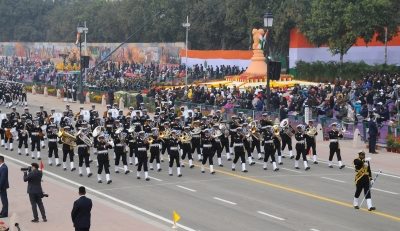New Delhi, Jan 26 : With armoured personnel carriers, artillery guns and new age battle tanks along with the rich cultural diversity of the states, India on Wednesday showcased its prowess on the occasion of 73rd Republic Day.
The grandeurs of the majestic Rajpath in the heart of the national capital were a sight to watch.The celebrations commenced after Prime Minister Narendra Modi paid tribute at the national war memorial.President Ram Nath Kovind arrived, escorted by his bodyguards on their magnificent bay and dark bay coloured mounts.
The President’s bodyguard, raised in 1773, is the senior most regiment of the Indian Army.
As the dignitaries were seated, a 21 gun Salute was presented by the ceremonial battery of 871 field regiment.
The 21 gun salute is usually presented during Republic Day, Independence Day and visits of foreign heads of states.
The first contingent in the uniform of the erstwhile Gwalior Lancers 61 Cavalry was led by Major Mrityunjay Singh Chouhan.
The 61 Cavalry is the only active serving horse cavalry regiment in the world.It was raised on August 1, 1953 with the amalgamation of six state forces’ cavalry units.
The Indian Army was represented by a Mounted Column of 61 Cavalry, 14 Mechanised Columns, six marching contingents and a fly past by Advanced Light Helicopters (ALH) of Army Aviation.One Tank PT-76 and Centurion (On Tank Transporters) and two MBT Arjun MK-I, one APC TOPAS and BMP-I (On Tank Transporter) and Two BMP-II, one 75/24 Towed Gun (On Vehicle) and two Dhanush Gun System, one PMS Bridge & Two Sarvatra Bridge System, one HT-16 (On Vehicle) and two Tarang Shakti Electronic Warfare System, one Tiger Cat Missile and two Akash Missile System were the main attraction in the mechanised columns.
A total of six marching contingents of the Army were there including the Rajput Regiment, the Assam Regiment, the Jammu and Kashmir Light Regiment, the Sikh Light Regiment, the Army Ordnance Corps and the Parachute Regiment.
The combined Band of the Madras Regimental Centre, the Kumoun Regimental Centre, Maratha Light Regimental Centre, Jammu and Kashmir Light Regimental Centre, Army Medical Corps Centre and School, 14 Gorkha Training Centre, Army Supply Corps Centre and College, Bihar Regimental Centre and Army Ordnance Corps Centre marched past the saluting dais.
The evolution of uniform and personnel weapons of the Indian Army over the last 75 years was the theme of the marching contingents.The contingent of the Rajput Regiment, wearing the uniform of the Indian Army of 1947, carried a .303 Rifle.
The Assam Regiment paraded in uniform of 1962 period and they also carried .303 Rifles.
The Jammu and Kashmir Light Regiment was seen in uniform worn during 1971.They carried a 7.62 mm self loading Rifle.
The contingent of the Sikh Light Regiment and the Army Ordnance Corps were in the present day uniform with 5.56 mm INSAS Rifle.
The contingent of the Parachute Regiment, donning the new Combat Uniform of Indian Army, unveiled on January 15, were carrying 5.56 mm x 45 mm TAVOR Rifle.
The Indian Air Force contingent comprised 96 airmen and four officers, led by Squadron Leader Prashant Swamyanathan.
The Air Force tableau was titled ‘Indian Air Force, Transforming for the Future’.
The tableau showcased scaled down models of MiG-21, Gnat, Light Combat Helicopter and Rafale aircraft, as well as the Aslesha radar.The tableaux were titled ‘Suite of Indigenously Developed Sensors, Weapons and Electronic Warfare Systems for LCA Tejas’ and ‘Air Independent Propulsion System’ developed for the submarines of the Indian Navy.
Defence Research and Development Organisation (DRDO) displayed two tableaux, signifying the defence technological advancements of the country.It was followed by tableaux of 12 States and Union Territories and nine Ministries and Departments, which were prepared on various themes under ‘Azadi ka Amrit Mahotsav’.
The tableaux were followed by cultural performances by 480 dancers chosen through an all-India dance competition ‘Vande Bharatam’.It is for the first time that dance groups, performed during the parade, have been chosen based on all India level competition.
As soon as all the tableaux finished their presentation, the women of the Border Security Force and the Indo-Tibetan Border Police (ITBP) stole the show with their daredevil stunts on the motorcycle.The brave and electrifying performances immediately fired up onlookers and visitors.
Taken aback with the scintillating performance, the visitors only stared at themselves open-mouthed.And with women doing such extreme stunts, it certainly gave an inspiration to millions of women across the country.
The grand finale and the most keenly awaited segment of the parade, the Flypast, for the first time, witnessed 75 aircraft and helicopters of the Indian Air Force displaying a number of formations.Vintage as well as current modern aircraft/helicopters like Rafale, Sukhoi, Jaguar, Mi-17, Sarang, Apache and Dakota displayed different formations, including Rahat, Meghna, Eklavya, Trishul, Tiranga, Vijay and Amrit.
The ceremony culminated with the national anthem and the release of Tricolour balloons.For the first time IAF coordinated with Doordarshan to show cockpit videos during the flypast.
uj/skp/
#India #military #cultural #diversity #Delhi #Narendra Modi # Narendra Modi #Vijay #Darshan #Dhanush #Arjun #Jan # Dhanush #Kota # Assam #Bihar #Delhi #New Delhi #Jammu And Kashmir #Jammu #Gwalior #Kota # Assam #Narendra
.






